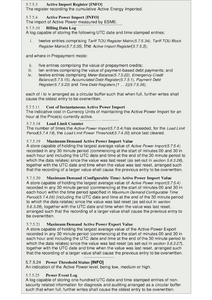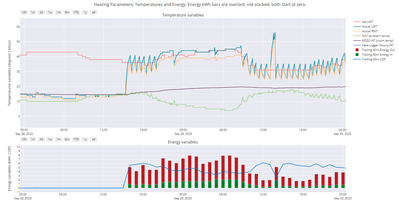In that case, at its simplest level, limiting instantaneous power draw fixes the problem. Supplement this by an ihd that connects to EV charger and heat pump, and also measures import power, problem solved. No need for internet or Indeed any external connectivity, thus no need for security.
Really not that difficult. The only infrastructure requirement is to swap the current main fuses for ones that blow in say 10s or whatever the grid needs, plus an escalating charge for call outs which doubles each time the call out is requested. Alternatively can smart meters already do limiting?
4kW peak of solar PV since 2011; EV and a 1930s house which has been partially renovated to improve its efficiency. 7kW Vaillant heat pump.
@jamespa It looks to me as though there are two possible options to curb the peak demand from domestic users. One being that we have to rely on consumers being sensible and responsible - the more likely option I feel is to embrace technology to handle the problem. Human error (and commitment) sounds like an unlikely option to me.☹️ Toodles.
Toodles, heats his home with cold draughts and cooks food with magnets.
Posted by: @toodlesIt looks to me as though there are two possible options to curb the peak demand from domestic users. [...]
No. The starting point must still be price.
Not only is Price the concept which consumers are already used to, and therefore able to be built upon,
but it must be a factor when anything to do with Smart Meters is involved.
Posted by: @jamespaAlternatively can smart meters already do limiting?
Yes. That is an option.
There are lots of functions related to Power measurement within Electric Smart Metering Equipment (ESMEs).
The Energy Suppliers have only implemented those of interest to them.
They're able to do that because the Regulator hasn't enforced the full SMETS2 specification...
which is what us consumers would find helpful!
Here's four bits of the SMETS2 Specification concerning Power, which I've bolted together.
That's why there are gaps in the numbering.
I'm not convinced that there needs to be anything more done to limit power input to the house.
We certainly can't be proposing any different type/value of Service Fuse.
That's a No-No because it's defined by safety parameters.
I'm not suggesting installing a FADeR instead of an IHD.
The Home Area Network (HAN) can have many different devices added to it, so the existing IHD can remain.
Posted by: @jamespaNo need for internet or Indeed any external connectivity, thus no need for security.
Erm... I wrote earlier that we do need internet connectivity in order to obtain data from the DNO and weather forecast for example.
But the communication would have to be instigated by the FADeR.
It won't be possible for an external 3rd-party to send commands to, or interrogate, the FADeR.
That's a tighter constraint than we currently have for Smart Meters, and there's no evidence of anyone trying to send packets to them across cell-networks.
Save energy... recycle electrons!
Posted by: @toodlesOne being that we have to rely on consumers being sensible and responsible
I think we can rule that out without further discussion.
Posted by: @toodlesthe more likely option I feel is to embrace technology to handle the problem
Absolutely. The question is what should the technology do? Command and control or distributed?. It's the ethernet vs token ring discussion (exactly the same same high level problem, shared resource with more than sufficient capacity on average but not sufficient capacity if everyone shouts at once, and a significant part of the demand that is not particularly time sensitive)
4kW peak of solar PV since 2011; EV and a 1930s house which has been partially renovated to improve its efficiency. 7kW Vaillant heat pump.
Posted by: @transparentI'm not convinced that there needs to be anything more done to limit power input to the house.
based on the information I have I completely agree, although I can see that this creates an allocation problem (how to decide teh limit -I believe France do it by price) and a problem of unnecessary over-restriction of resource when there is spare capacity (which is presumably most of the time).
I frequently pull people up when they criticise Government without knowing the full facts, so I must be careful not to fall into the same trap myself. So before I criticise the it, what are the constraints (political or technical) forcing NESO into the current, apparently clumsy, command and control strategy?
Posted by: @transparentErm... I wrote earlier that we do need internet connectivity in order to obtain data from the DNO and weather forecast for example.
But the communication would have to be instigated by the FADeR.
Limiting power to the house doesnt need internet connectivity. Internet connectivity is only needed to override the limits in times of plenty.
Posted by: @transparentWe certainly can't be proposing any different type/value of Service Fuse.
That's a No-No because it's defined by safety parameters.
Fair enough, but power can be limited in other ways with the service fuse as a backstop.
4kW peak of solar PV since 2011; EV and a 1930s house which has been partially renovated to improve its efficiency. 7kW Vaillant heat pump.
Posted by: @jamespaLimiting power to the house doesnt need internet connectivity. Internet connectivity is only needed to override the limits in times of plenty.
From the consumer's viewpoint, he's still going to constrain his power demand based on price.
The FADeR is a "look ahead" device in addition to being able to tell a battery to import.
That's 'battery' in a very general sense. It could be:
- an in-home (lithium) cell array, supplied via a mains inverter
- an immersion heater in a tank of water
- a ZEB, storage radiators, or other type of dry heat store
Using the internet, the FADeR has access to the weather forecast for the next few days, which provides a fair prediction of the Heat Pump's requirements.
It's akin to knowing the OAT in advance.
The weather forecast also allows an estimate of how much power might be expected from any rooftop solar (if present).
The FADeR can now calculate the demand which must be met by the grid over at least 48-hours.
Once that's known, the power demand can be picked up from the grid over as long a timeframe as possible.
Thus we use little bandwidth at the 11kV level,
whilst simultaneously reducing those "losses due to phase-imbalance" at the LV level. 🙂
DNOs already know the power demand and energy-mix for each Bulk Supply Point 10-days in advance.
It's rare that this is now made available publicly, but WPD used to make it accessible.
That's how I got the hourly histogram for Twelveheads BSP earlier.
Basically, the data is there if it's required, and would require collection via the internet.
NESO actually start planning supply & demand six months in advance.
As each half-hour time-slot becomes closer, more detail is added.
That's how they negotiate with Generators to either deliver power, or to be held on stand-by.
At the moment I can't provide further information on how the FADeR derives data on the available capacity in the 11kV network.
That's not because I don't want to, but I'm still monitoring the local grid before devising a system.
The available 11kV capacity isn't required far in advance.
It's basically a Just In Time principle.
I'd also like to make this element of the equation come from community-based intelligence, rather than paying DNOs to install monitors and provide the service.
A DNO-based system would be fearfully expensive, for reasons I could elaborate on if you want.
Community intelligence would also make this truly "consumer-led", rather than only in name. 😉
The organisations/companies which might 'lose out' from this strategy would be those who want to scatter containers of Lithium Batteries across the country.
Their approach is to use the local 11kV network twice.
They charge from the grid when they can get a good price, then sell back the stored charge when the wholesale market gives them a nice profit.
But double-use of the 11kV grid (and the LV level) needs to be avoided.
There isn't enough capacity to allow 3rd parties to waste the bandwidth purely for financial gain.
Moreover those companies don't have monitoring at the far end of the 11kV supply to which they connect.
So when they import/export using their battery, they're operating blind.
They have no idea if they're taking the remote ends of that Feed outside its statutory limits.
Is this becoming clearer?
Save energy... recycle electrons!
Posted by: @transparentThe FADeR can now calculate the demand which must be met by the grid over at least 48-hours.
Once that's known, the power demand can be picked up from the grid over as long a timeframe as possible.
Do we need to do the look ahead stuff to make this work. Surely a simple algorithm: If I have a battery, fill it when the grid has capacity will do, just like happens now with batteries and price.
Essentially you are assuming home storage, which seems to me to be obviously a part of the solution given that the problem is load levelling not load reduction. Why have NESO apparently discarded this option (I can think of possible reasons but it would be good to know the actual one). Until we understand that we cant make progress I feel.
4kW peak of solar PV since 2011; EV and a 1930s house which has been partially renovated to improve its efficiency. 7kW Vaillant heat pump.
Posted by: @transparentis it possible to provide a reasonable estimate of the extra electricity it would consume during the time taken to raise the temperature
back to the normal setting?
This is the very question @jamespa and I have grappled with for ages, because another way of asking the same question is do setbacks save or use more energy/save money of cost more. The short answer is we still don't have a definitive answer, @jamespa has I think suggested they can cost more (correct me if I am wrong), I incline to the view, nothing more robust that that, that they might save a bit, with a minor comfort penalty.
The main problem is there is no adequate 'model' for how a real building behaves in the real world, and to make things worse, it is a truism to say no two buildings are the same. I do have plenty of empirical data for my house, but that tells us nothing about your house.
The other huge problem with heat pump setbacks, however initiated, is that a properly designed heat pump system has very little reserve. In milder weather it will have enough (at a penalty of lower COP), but when it is cold outside, which is when it matters most, the heat pump will struggle.
Here is my heat pump getting the house up to temperature from a standing start (IAT 14.5°C) when I turned the heating on recently:
My 'auto-adapt' script was running (boost the LWT a bit by raising the WCC when the IAT is too low), but the boost is small, 1-2°C. As you can clearly see, it took the best part of 18 hours to 'recover' to my normal IAT of 18-20 hours.
The whole government thing as I have said before is pure Orwellian BS to cover up an even more terrifying regime where Big Brother will micro-manage every aspect of our lives. We should never have given in to that government covid lockdown crap, they now think they can do anything!
Midea 14kW (for now...) ASHP heating both building and DHW
Posted by: @transparentI don't think Heat Pump control electronics would attempt the recovery in the same time as the switch-off.
My understanding of HP control systems tells me that it will increase the Flow temperature and rate.
That lowers the COP...
... which means that a higher proportion of the recovery heat will be coming from electricity and less 'from the air'.Consequently, the overall process will increase the quantity of electricity we must generate nationally.
I'd like to draw that as a diagram.
But I'd need to have a good estimate for how much the COP would fall during the recovery period,
and an idea of what a (theoretical) typical ASHP would do with Flow Temperature and Rate.I don't have such figures.
That's where I'm hoping @jamespa @cathoderay and others here might be able to provide some reasonable approximations.
With my brief rant (above) now done, yes, we can provide reasonable approximations (actually they are better than that, they are real world observations) for our particular property. I have countless observation periods of exactly what happens in my property after a set back. But that is as far as it goes. If you had enough individual data sets, then you could start to make some general assumptions. But that is a huge undertaking, because you need to install detailed monitoring in every property you wish to study. Most people are not going to do that, either because the can't (don't have the necessary knowledge and skills) or won't (my energy use is none of your business).
At the risk of stating the obvious, it is plain to see that any system of government led setback management is bound to fail, certainly in terms of comfort, and in more extreme cases in health, but also very possibly in terms of saving energy (and money), and of course there are the wider social implications I often bring up, unless there is sufficient energy storage capacity in each and every property (and even then, the physics may blow any imagined benefits out of the water). Getting that to happen from where we are now is pure fantasy, we can't even get people to install heat pumps in reasonable numbers. Truly the lunatics are in charge of the asylum.
Midea 14kW (for now...) ASHP heating both building and DHW
Posted by: @cathoderayAt the risk of stating the obvious, it is plain to see that any system of government led setback management is bound to fail
Completely agree. To my mind this is not worth the effort of engaging with such a solution, either
- we will abandon net zero altogether, which seems not improbable. This will have absolutely disastrous consequences IMHO, not just in terms of the climate but in terms of our increased dependence on despot, and increasingly desperate, states for our energy supplies whilst China and progressive countries enjoy abundant essentially free energy
- the problem will be solved another more sane way, or
- it wont be solved, there will be blackouts, the rich will protect themselves with batteries and the poor will shiver
Based on what @transparent is telling us my bet is on (1) or (3)
4kW peak of solar PV since 2011; EV and a 1930s house which has been partially renovated to improve its efficiency. 7kW Vaillant heat pump.
Posted by: @jamespaEssentially you are assuming home storage, which seems to me to be obviously a part of the solution given that the problem is load levelling not load reduction.
Yes, but it doesn't need to be widely implemented in order for the autonomous home-based controller approach to be effective.
It takes only one or two houses in the street with an EV charger or solar panels to create a significant amount of phase-imbalance losses.
Equally, it takes very few houses with storage capability to provide a useful amount of load-levelling.
My preference would be to incentivise social housing landlords to install (various types of) storage in their properties.
That would bring down energy costs and provide resilience to those likely to have pre-payment meters and/or be in energy poverty.
It would also gain universal public approval, which matters in a scheme which is to be 'consumer-led'.
Posted by: @jamespaWhy have NESO apparently discarded this option
Well it's not NESO who are heading up the SSES strategy.
It's Government.
That puzzles me.
When SSES was first consulted on in 2022, NESO didn't exist. The grid operator was a private company, National Grid ESO.
But I don't see why DESNZ is still attempting to legislate on matters pertaining to electricity supply & demand.
Once the Energy Act (Nov 2023) gained Royal Assent, I would've expected SSES to be passed across to NESO.
As ordinary consumers, we still have great difficulty making our voice heard to both NESO and DESNZ. 🙄
Both organisations spend most of their listening time in meetings with representatives of the commercial energy sector.
The result is that any proposed strategy must make money for the players.
That, in turn, drives up the majority of consumer bills...
which makes DESNZ's claim sound hollow:
That implies only those households who buy into CLF would see lower bills.
Everyone else will be charged more in order to pay
- the compensation for those who have taken part in the CLF service
- the estimated £1.7m per year running costs to Elexon, incl the 2-year set-up costs before CLF becomes 'active'
Save energy... recycle electrons!
Posted by: @transparentWhy have NESO apparently discarded this option
Well it's not NESO who are heading up the SSES strategy.
It's Government.That puzzles me.
OK thanks for that, but the basic question remains, why has a solution based on home storage been discarded?
There must be a reason and, unless we understand it, arguing for a solution which is based on home storage is bound to fail, however technically sensible it may be. Nodal pricing was nixed on political grounds not technical ones. If politics is driving the approach to grid load management, then no amount of technical argument alone will defeat it. The argument itself (and therefore the technical solution) needs to deal with the political barrier/imperative.
Posted by: @transparentBoth organisations spend most of their listening time in meetings with representatives of the commercial energy sector.
The result is that any proposed strategy must make money for the player
Of course they do, there is nobody else they can turn to who demonstrably has the technical expertise and the heft to deliver and I think its fair to assume that the Civil Servants are, at least for the most part, not technical. Thats a fundamental problem with our government IMHO, so far as I can tell (and I admit I may be wrong and would dearly love to be proven wrong) we stripped most of the technical expertise out of the civil service decades ago, and so are almost entirely reliant on the private sector for technical input. I cant see that changing in the short or even medium term. Obviously the private sector is solely motivated by profit.
4kW peak of solar PV since 2011; EV and a 1930s house which has been partially renovated to improve its efficiency. 7kW Vaillant heat pump.
- 26 Forums
- 2,342 Topics
- 53 K Posts
- 233 Online
- 6,000 Members
Join Us!
Worth Watching
Latest Posts
-

RE: Are We Sleepwalking Into Another Race to the Bottom?
…otherwise known as “hive got news for you”. And don’...
By Majordennisbloodnok , 10 hours ago
-
RE: Configuring third party dongle for Ecodan local control
Logically, I'll fall into that category so the natural ...
By Sheriff Fatman , 10 hours ago
-

RE: Controlling Daikin Altherma via P1P2 and Home Assistant
I haven’t got a Daikin but I have been having some fun ...
By Majordennisbloodnok , 11 hours ago
-

RE: Setback savings - fact or fiction?
@robs — thanks again for your detailed comments. Some r...
By cathodeRay , 13 hours ago
-
RE: Free Ecoheat Heat Pump Install
I don't mind thread drift, it's how conversation natura...
By Deltona , 15 hours ago
-

RE: A Smarter Smart Controller from Homely?
@papahuhu I hope you get a swift resolution. Regards, T...
By Toodles , 17 hours ago
-

RE: Poll for Time of Use, tariffs, technology
That’s fine by me too Major, I feel it is a sad reflect...
By Toodles , 18 hours ago
-

Bingo. Sometimes a judiciously placed size 10 bovver bo...
By Majordennisbloodnok , 19 hours ago
-
RE: Mitsubishi Ecodan 11.2kW heat pump with low COP
@ciocoiu-alexandru I can't provide the same level of di...
By Sheriff Fatman , 19 hours ago
-
RE: Octopus Cosy Heat Pump Owners & Discussion Thread
Recently had my follow up with octopus for the vibratio...
By swwils , 20 hours ago
-

The three technical issues I'm considering are: BMS...
By Transparent , 21 hours ago
-
RE: LiFePO4 lithium battery fires and explosions
@transparent Your post may fit better in th...
By Batpred , 21 hours ago
-

RE: British Gas vs Octopus Energy vs Heat Geek vs EDF vs Aira vs OVO vs EON.Next vs Boxt
@jamespawhite, if you could be bothered, you could also...
By Mars , 23 hours ago
-
RE: Commencing on an ASHP Installation Process
I've got a bit of time to draft something today, so the...
By Sheriff Fatman , 2 days ago
-
RE: Help with heat pump sizing
@amin I dont think materially relative to t...
By JamesPa , 2 days ago
-

@majordennisbloodnok I have decided to take the plunge....
By TechnoGeek , 2 days ago
-
RE: Different dT on each radiator?
I cant sorry. Its based on some calculations I did fro...
By JamesPa , 2 days ago
-
RE: Help me keep the faith with my air source heat pump installation
@simonf thats interesting as I’ve noticed my flow and r...
By AdamK , 3 days ago







